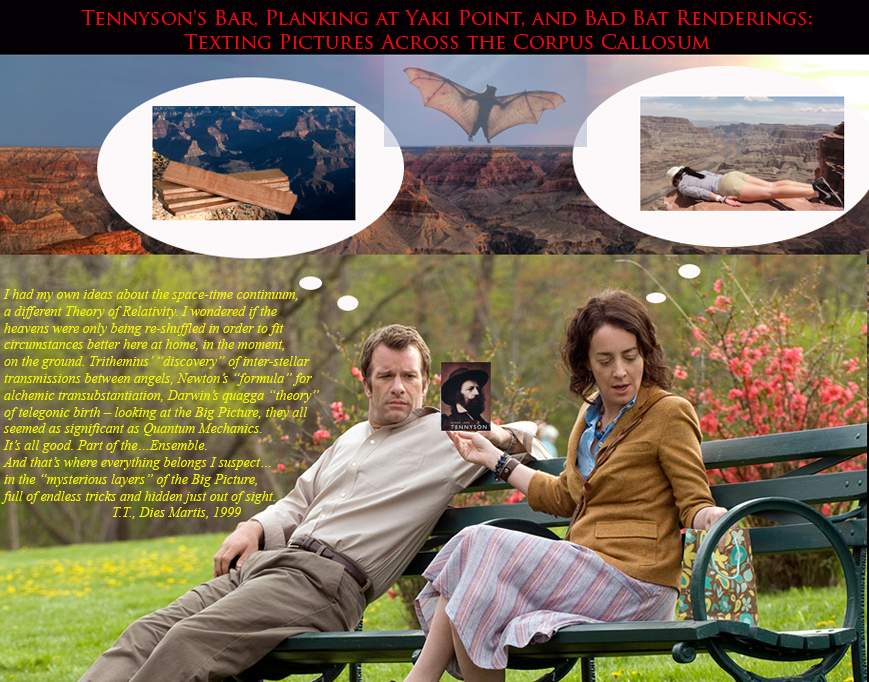Some news: The Pen/Hemingway Award for Literary Excellence in Debut Fiction is issuing a press release today. Here’s a hint: If Yellow Birds is to Open City, then As It Is On Earth is to The Art of Fielding.
But enough about me. It’s Thursday; I’ve a bat in the belfrey, and we have some fish to fry (…sorry, couldn’t resist).
I assume by now that everyone has noticed the pictures. Yes?…
Clearly, something needs to be said. And not just to remind you that I’m an architect by training (let’s face it, Adobe Photoshop owns us).
If it is true that a picture is worth a thousand words, then here are about eight hundred or so of them on behalf of Rumination’s…photobombs.
Firstly, I want to insist that a picture is most assuredly not worth a thousand words. That would mean that all words are of equal value. No way. I adore the one hundred and nine poetic words from Tennyson’s mortal sailor as he is Crossing the Bar, but I assume “Duck!” would be more profitable when the boom tries to clock him on the downwind jibe.
That said, there is no doubt that pictures are inextricably bound up with words. If you’re a believer in the correspondence theory of language, you believe that words render a picture of reality. I’m a Richard Rorty fan and, so, do not believe in the correspondence theory; I think reality and language are a lot trickier with one another than that. But I do believe that pictures are a big deal. Particularly, the way words stick to them like glue.
“Picturing” is something we do. A lot. No choice. Picturing helps us to imagine what’s up ahead, to recall what has passed, and, most importantly, to steer present conversations along. When words seem to fall short?…the talk shifts even more explicitly to the making of pictures. And, sometimes this goes well, other times not so.
For example, “Picture this…,” your friend says, turning to you from her seat on a park bench; she’s sharing an intimate experience. Out come your Conte crayons (or, perhaps the FaberCastell 4B, the chinese horsehair brush, maybe the Vivitar digital camera – whatever it is you use up top for depicting the flux).
Suddenly, the conversation begins to veer off-track. You interrupt, “Wait, I pictured someone else entirely?” Your corpus callosum steps back from the easel.
“Oh,…” your friend responds, shifting uneasily as she looks away, across the park, “He’s no longer in the picture.” Oh, shit!…my bad, you think. Out comes the eraser.
The conversation goes along, but the picture is already framed. Even when your friend finishes up and says, “Now, do you get the picture?…”, you don’t, not really, not that one. You’re too busy hanging the gaffe you just made over the mantle piece. Pictures are like that; they’re hard to paint over. Best to just start a new one.
Wittgenstein once said “What can be shown, cannot be said.” I think what he meant by this, roughly, is that once our eyes alight on something new, it “disappears” the moment we use words to describe it. That’s why Walker Percy believed that only one person ever truly saw the Grand Canyon* – the very first fellow to the rim. After that, it disappeared into its representation in language. Imagine the canyon’s first viewer to his (or her) buddy: “I just saw the coolest thing out there in the desert, picture this…” Poof, there goes the canyon. The guy is now saddled with an image in his head like a stuck tune, all the way to Yaki Point. And there’s no way to overlook it, even there…on the Overlook. Fortunately, the Grand Canyon is still pretty amazing, so no need to feel too gypped for arriving late. Go ahead and draw a picture for the next guy.
I hope you get my point. Now, to my photobombs.
A few weeks ago, I wrote about ears turning outside-in to hear the tone of written words. One might also say that our eyes turn outside-in to see pictures rendered by written words. Not the graphemes, of course, but the images that their arrangement conjure.
As I tried to indicate with the couple in the park, translation from words to pictures can easily go awry (granted those were spoken words but, no quibbling allowed at Ruminations...).
My crude photoshop work is here to help – a little lagniappe, as Esther might say. Heralding in each week’s topic, the pictures provide an opportunity for your head…well, to get a head start. They’re also there to ease the physical strain. Eyeballs are designed to roll only part way (again, you have my permission) – not the full one hundred and eighty degrees necessary to see whatever screwy picture your mind’s drafting tools are rendering as you read this. As I said before, picturing is what we do, I didn’t say we do it particularly well. Unfortunately, subjectivity guarantees this…We do the best we can, but, clearly, it is way hard to share our pictures with anyone else**.
How could it be otherwise?
* See Walker Percy’s wonderful old essay, The Loss of the Creature.
** See Thomas Nagel’s wonderful old essay, What Is It Like To Be A Bat?








